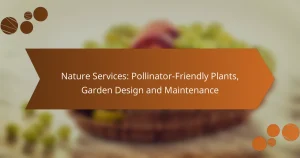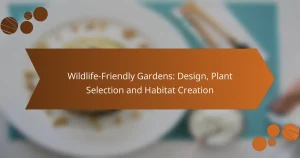Nature services in Los Angeles play a vital role in enhancing local ecosystems and promoting community well-being. By engaging in initiatives such as tree planting, native landscaping, and wildlife habitat restoration, residents can contribute to a healthier environment that supports clean air, water management, and biodiversity.
Trees: Signs of Distress, Professional Care Needs and Solutions
Trees in urban environments can show signs of distress that indicate they are struggling to thrive. Early recognition of these signs is crucial for taking appropriate action to restore their…
Nature Services: Pollinator-Friendly Plants, Garden Design and Maintenance
Creating a pollinator-friendly garden is essential for supporting local ecosystems and enhancing biodiversity. By selecting native and drought-tolerant plants, you can provide vital resources for bees, butterflies, and hummingbirds while…
Community Clean-Up Events: What to Expect and How to Participate
Community clean-up events are a fantastic way to engage with your local environment and make a positive impact. Volunteers come together to clean public spaces, plant greenery, and raise awareness…
Wildlife-Friendly Gardens: Design, Plant Selection and Habitat Creation
Creating a wildlife-friendly garden is a rewarding endeavor that enhances biodiversity while beautifying your outdoor space. By selecting native plants, providing water sources, and incorporating shelter, you can cultivate an…
Local Water Restrictions: Compliance, Impact and Adaptation Strategies
In response to ongoing drought conditions, Los Angeles has implemented water restrictions to promote conservation and ensure a sustainable supply for its residents and businesses. Compliance with these regulations requires…
Eco-Friendly Landscaping: Cost Comparison with Traditional Methods
Eco-friendly landscaping is increasingly recognized as a sustainable and cost-effective alternative to traditional landscaping methods. While the initial investment may be higher, the long-term benefits, including cost savings and enhanced…
Shrub Maintenance: Best Practices for Urban Health
Effective shrub maintenance is vital for enhancing urban biodiversity and creating green spaces that support wildlife. By implementing best practices such as proper pruning, consistent watering, and soil management, urban…
Community Environmental Engagement: Resources, Tools and Support
Engaging local communities in environmental initiatives is essential for promoting sustainability and enhancing community spirit. By leveraging resources such as government grants and non-profit support, communities can access the funding…
Nature Services: Transitioning Your Lawn to Organic Care in 3 Months
Transitioning your lawn to organic care is a rewarding journey that can be accomplished in just three months. By gradually replacing synthetic fertilizers and pesticides with natural alternatives, you can…
Nature Services: Soil Health for Organic Lawn Success
Soil health is essential for cultivating a successful organic lawn, particularly in regions like Los Angeles. By enhancing nutrient availability, improving water retention, and fostering microbial activity, healthy soil creates…
What nature services are available in Los Angeles?
Los Angeles offers a variety of nature services aimed at enhancing local ecosystems and improving community well-being. These services include tree planting, native landscaping, wildlife habitat restoration, stormwater management, and community gardening programs.
Tree planting services
Tree planting services in Los Angeles focus on increasing urban greenery, which helps improve air quality and provides shade. Local organizations often coordinate tree planting events, allowing residents to participate and contribute to their neighborhoods.
Consider factors like the type of trees suitable for the local climate and soil conditions. Native species are often preferred as they require less maintenance and support local wildlife.
Native plant landscaping
Native plant landscaping promotes the use of indigenous plants that thrive in the local environment, reducing water usage and maintenance needs. This approach not only conserves resources but also enhances biodiversity by providing habitats for local wildlife.
Homeowners can consult with landscape professionals to design gardens that incorporate native plants. Resources like the California Native Plant Society offer guidance on selecting appropriate species for various settings.
Wildlife habitat restoration
Wildlife habitat restoration in Los Angeles aims to rehabilitate degraded ecosystems, creating spaces for native animals and plants to thrive. This can involve removing invasive species, restoring native vegetation, and improving water quality in local habitats.
Community involvement is crucial for successful restoration projects. Residents can participate in volunteer days or educational workshops to learn about the importance of local ecosystems and how to help restore them.
Stormwater management solutions
Stormwater management solutions in Los Angeles are designed to reduce runoff and improve water quality. Techniques include rain gardens, permeable pavement, and bioswales, which help absorb rainwater and filter pollutants before they reach waterways.
Implementing these solutions can mitigate flooding and erosion while enhancing local landscapes. Homeowners should consider consulting with local environmental agencies to explore available options and incentives for sustainable practices.
Community gardening programs
Community gardening programs in Los Angeles provide residents with opportunities to cultivate their own food while fostering community connections. These gardens often emphasize sustainable practices and can serve as educational hubs for gardening and nutrition.
Joining a community garden typically involves a small fee or commitment to maintain the space. Interested individuals can find local programs through city websites or community organizations dedicated to urban agriculture.
How can nature services improve local environments?
Nature services enhance local environments by supporting ecosystems that provide essential benefits, such as clean air, water management, and biodiversity. These services can lead to healthier communities and more resilient urban landscapes.
Enhance biodiversity
Enhancing biodiversity involves increasing the variety of plant and animal species in a local area. This can be achieved through initiatives like planting native vegetation, creating wildlife habitats, and reducing pesticide use. A diverse ecosystem is more resilient to changes and can better support food webs.
For example, community gardens or urban parks that incorporate native plants can attract pollinators and other beneficial species, promoting ecological balance. Local governments may offer incentives for residents to participate in biodiversity-enhancing projects.
Improve air quality
Improving air quality can be accomplished through the strategic planting of trees and vegetation, which absorb pollutants and produce oxygen. Urban areas with more greenery often experience lower levels of harmful emissions and particulate matter.
Consider planting trees along streets and in parks to create natural barriers against air pollution. According to studies, urban forests can reduce air pollution by as much as 20-30%, leading to healthier living conditions for residents.
Reduce urban heat
Reducing urban heat involves implementing green infrastructure, such as green roofs, parks, and shaded areas, to mitigate the heat island effect common in cities. These features can lower surface and air temperatures, making urban areas more comfortable during hot months.
For instance, a well-placed tree canopy can reduce temperatures by several degrees, providing relief in residential neighborhoods. Local policies may encourage the installation of green roofs on commercial buildings to further combat urban heat.
Manage stormwater runoff
Managing stormwater runoff is crucial for preventing flooding and protecting water quality. Nature-based solutions, such as rain gardens and permeable pavements, help absorb and filter rainwater, reducing the burden on drainage systems.
Implementing these features can significantly decrease the volume of runoff, with rain gardens capable of capturing a substantial portion of rainfall. Communities should consider integrating these solutions into new developments and retrofitting existing infrastructure to enhance stormwater management.
What are the benefits of using local nature services?
Local nature services provide numerous advantages, including enhanced biodiversity, community involvement, and increased property values. By utilizing these services, communities can foster a healthier environment while promoting sustainable practices.
Support local ecosystems
Using local nature services helps maintain and restore ecosystems that are vital for biodiversity. These services often include habitat restoration, native plant landscaping, and wildlife conservation efforts, which contribute to a balanced environment. For example, planting native trees can attract local wildlife and improve air quality.
Communities can engage in activities like tree planting days or wetland restoration projects, which not only support ecosystems but also educate residents about their local environment. Collaborating with local environmental organizations can amplify these efforts.
Boost community engagement
Local nature services encourage community involvement by providing opportunities for residents to participate in environmental stewardship. Activities such as community gardens, clean-up events, and educational workshops foster a sense of belonging and responsibility among participants.
Engaging with nature services can also strengthen social ties, as neighbors work together towards common goals. This collaboration can lead to increased volunteerism and a more vibrant community spirit.
Increase property values
Investing in local nature services can lead to higher property values in the surrounding area. Properties near parks, green spaces, or well-maintained natural features often see appreciation due to their appeal to potential buyers. Studies indicate that homes near parks can sell for significantly more compared to those farther away.
Homeowners can enhance their property values by incorporating native landscaping or participating in community beautification projects, making their homes more attractive to buyers who value environmental sustainability.
Promote sustainable practices
Local nature services play a crucial role in promoting sustainable practices within communities. By encouraging the use of native plants, organic gardening, and water conservation techniques, these services help reduce environmental impact. For instance, rain gardens can manage stormwater runoff effectively while enhancing local aesthetics.
Communities can adopt sustainable practices through workshops and educational programs that teach residents about composting, recycling, and energy-efficient landscaping. This knowledge empowers individuals to make environmentally friendly choices that benefit both their households and the larger community.
What criteria should you consider when choosing nature services?
When selecting nature services, consider the provider's experience, the types of services they offer, cost and budget, and client testimonials. These factors will help ensure that you choose a service that meets your environmental needs effectively.
Service provider experience
Evaluate the experience of the service provider by looking at their years in the industry and their track record with similar projects. A provider with extensive experience is more likely to understand local ecosystems and regulations, which can lead to better outcomes.
Ask for examples of past projects and inquire about any certifications or training their staff may have. This information can provide insight into their expertise and reliability.
Types of services offered
Different nature services can include habitat restoration, invasive species management, and environmental education programs. Identify which specific services align with your environmental goals and community needs.
Consider whether the provider offers customizable solutions or packages that cater to various aspects of environmental management. This flexibility can be crucial for addressing unique local challenges.
Cost and budget considerations
Understanding the cost structure of nature services is essential for effective budgeting. Prices can vary widely based on the type of service, the scope of the project, and the provider's reputation.
Request detailed quotes from multiple providers to compare costs. Be mindful of any hidden fees and ensure that the services included meet your expectations to avoid overspending.
Client testimonials and reviews
Client testimonials and reviews can provide valuable insights into the quality of service a provider offers. Look for feedback on their reliability, professionalism, and the effectiveness of their services.
Check online platforms and local community boards for reviews. Positive testimonials from previous clients can help you feel more confident in your choice, while negative reviews may signal potential issues to consider.
What permits are needed for nature services in California?
In California, obtaining permits for nature services typically involves a combination of local, state, and federal regulations. The specific permits required can vary based on the type of service, the location, and the environmental impact of the project.
Types of permits required
Common permits include the California Environmental Quality Act (CEQA) review, which assesses potential environmental impacts, and local permits from city or county agencies. Depending on the project, you may also need permits related to water quality, endangered species, or land use.
For example, if your project involves wetland restoration, you might need a Section 404 permit from the U.S. Army Corps of Engineers. It's crucial to identify all applicable permits early in the planning process to avoid delays.
Steps to obtain permits
Start by consulting with local planning departments to understand specific requirements for your nature service project. Prepare necessary documentation, including environmental assessments and project plans, to support your permit applications.
Engaging with stakeholders, such as local communities and environmental groups, can also facilitate the permitting process. Be prepared for potential public hearings or reviews, which can influence the outcome of your application.
Common pitfalls to avoid
One common pitfall is underestimating the time required to secure permits. The process can take several months or longer, depending on the complexity of the project and the responsiveness of regulatory agencies.
Another issue is failing to conduct thorough environmental assessments, which can lead to permit denials. Ensure that all required studies are completed and that you comply with all local, state, and federal regulations to streamline the process.






